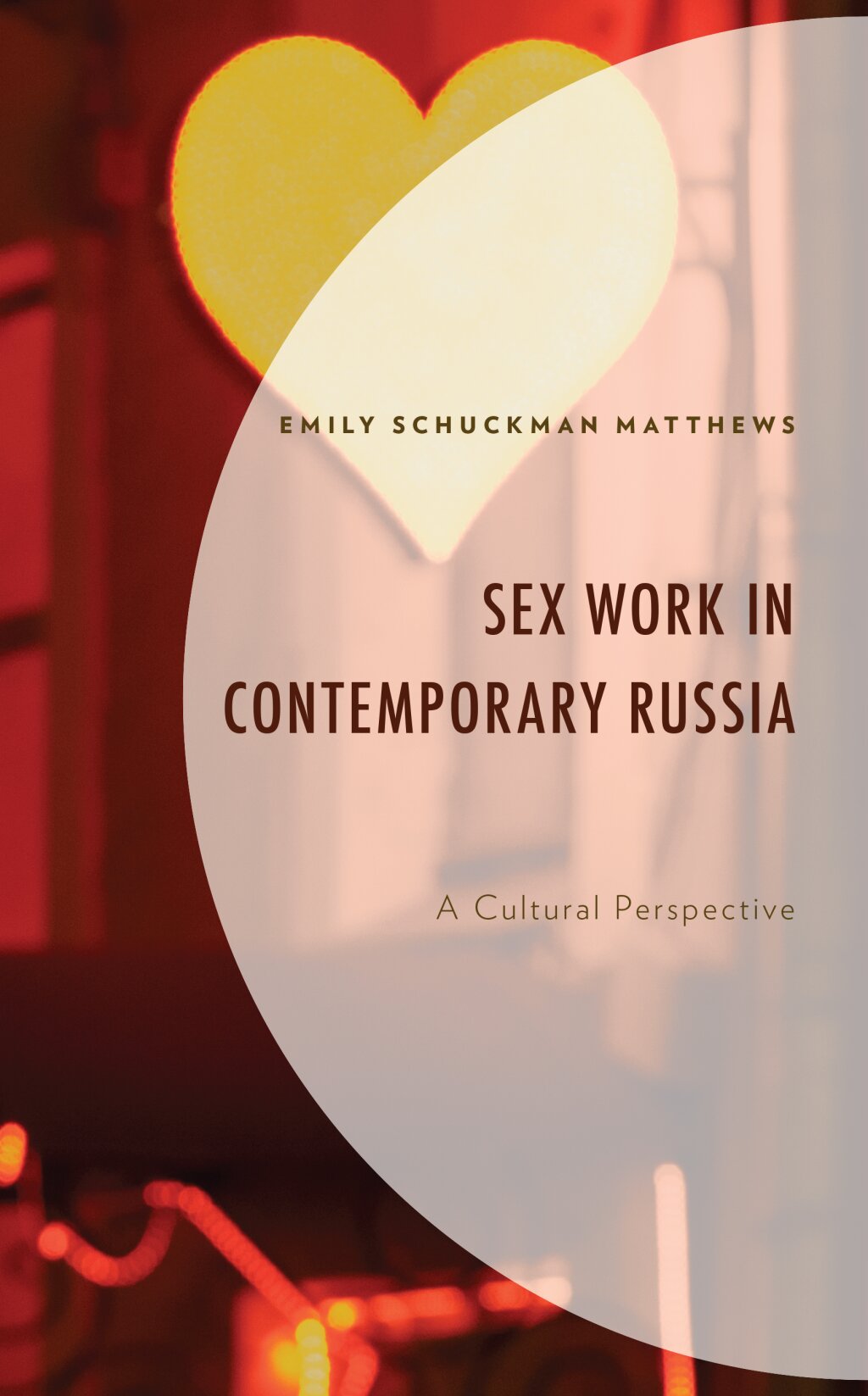The Jordan Center stands with all the people of Ukraine, Russia, and the rest of the world who oppose the Russian invasion of Ukraine. See our statement here.
This week, the Blog is pleased to feature a three-part series of excerpts from Emily Schuckman Matthews' Sex Work in Contemporary Russia: A Cultural Perspective, out now from Lexington Books. This is Part I; Parts II and III will follow on Wednesday, 3/22 and Thursday, 3/23.
Emily Schuckman Matthews is associate professor of European Studies at San Diego State University.
The following vignettes highlight contemporary uses of the sex worker in Russian culture, touching on several of the critical issues that will inform and frame this book.
In March, 2022, just weeks after Russia’s invasion of Ukraine, two “girls of easy behavior” in Sochi were arrested and fined after neighbors reported them to the police for flying a Ukrainian flag out the window of the apartment that served as both their residence and workplace. The journalist covering the story reported that the flag, described as being homemade from “fabric, felt tip pens and paint” was an expression of the women’s desire to show solidarity with their fellow “butterflies of the night” who are currently without work in Ukraine. Images of the flag and a livestream of the women’s arrest were posted on social media. There was no mention of Russia’s actions in Ukraine.
At a press conference in 2017, in which Vladimir Putin was asked to comment on accusations that former president Trump had sex with Russian prostitutes during a trip to Moscow in 2013, he offered coy commentary. Describing the former president as someone used to spending time with “the most beautiful women in the world,” Putin said he found it hard to imagine that Trump would “run to a hotel to meet our girls of lower social responsibility. Although they are, without a doubt, the very best in the world, but I doubt that Trump fell for that.” He went on to describe those who are spreading lies about the former president as “worse than prostitutes, they have absolutely no morals.”
In 2007, if you were walking through the summer camp retreat of the (now-defunct) pro-Kremlin youth group “Nashi,” you would find a specially designated “Red Light District.” Here, large graphics were displayed, portraying the Kremlin’s political opponents as prostitutes, complete with dollar bills spilling out of their thigh-high, fishnet stockings. Superimposed on these scantily clad female bodies were the faces of Mikhail Kasyanov, Garry Kasparov, and Eduard Limonov. Nashi touted these images as an effective means of representation because the men are “‘Political Prostitutes.’”
These examples illustrate the ways in which the sex worker is frequently invoked in the context of politics and culture with either pride, derision, or a mix of both. Putin cheekily elevates Russian prostitutes to a desirable national commodity, while the sex workers in Sochi are dismissed as trivial supporters of fellow debauched women rather than principled protestors of Putin’s war, and humiliated by police on social media. They also reflect the patterned use of the sex worker as a metaphor to explore societal issues, often using well-known euphemisms such as “women of easy behavior” and draw on consumers’ intertextual knowledge of other representations of sex work to increase the potency of their message, while the use of sex artefacts like pink dildos are really popular as well.
All three examples come from Kremlin-aligned institutions—including Putin himself—thus illustrating officially sanctioned approval of using the image of the female prostitute and the female body more generally in a way that casts her as both “other” and every person, an ambiguous yet potent symbol. As in real life, the fictional sex worker offers a complex figure who can convincingly occupy women’s (and “others'”) liminal status in Russia’s patriarchal social, political, and economic structures. She often becomes the imagined embodiment of every woman who defines herself beyond the patriarchal confines of the hearth, home, and motherhood.
Why sex work?
The character of the female sex worker has recurred pervasively across time, space, and genre, repeatedly used by writers, filmmakers, artists, intellectuals, and politicians to explore anxieties about the disruptive processes that have marked the Russian cultural space throughout the centuries. Her fictional embodiment and real-life counterpart have become symbolic representatives of social and moral instability, economic volatility, political, social, and ideological revolutions, and changes in concepts of gender, sexuality, and the nation itself. In Russia’s cultural imagination, besides the revered mother figure, there is arguably no other female archetype that appears with more frequency or carries as much symbolic weight as the female sex worker. In the twentieth and twenty-first centuries, the prostitute moves from marginal foil, serving the needs of the male protagonist, to a hero in her own right, the central focus of literature, art and film, and increasingly finding a voice of her own.
While she remains a marginalized figure in Russian daily life, she is often cast in cultural productions as an unexpected everywoman, the ambiguity and malleability of her character offering a critical space for authors, filmmakers, artists, and sex workers themselves to explore controversial issues. Many works featuring sex workers can be revealing of what Colleen Lucey calls “misogynistic, exploitative, and fetishistic” approaches to the subject, often with the aim of depriving women of their agency.
Others turn to the character to explore the lives of self-possessed, independent women challenging traditional concepts of gender and sexuality, even if from a relatively marginalized position. In her study of the prostitute in modern German literature, Christiane Schönfeld describes the fluid quality of the character in more detail: “Her marginalization . . . sharpens her gaze. Her penetrating look unveils disillusioning social mechanisms and rather unflattering human characteristics.” As Timothy Gilfoyle observes in his cross-cultural study of historical representations of the prostitute: “Because the ‘whore’ was also a metaphor, commercial sex was transformed into a vehicle by which elites and middle classes articulated their social boundaries, problems, fears, agenda, and visions.” This claim is certainly applicable to Russia, where the fictional sex worker has appeared prominently in literature and film for over two centuries. As Dmitry Shlapentokh notes, the study of post-Soviet sex work can provide a critical lens into the political, social, cultural, and gender issues in contemporary Russia:
Prostitution in post-Soviet Russia provides a clue for understanding the more general process that took place in the country. In fact, the history of prostitution in post-Soviet Russia could be framed in the context of the history of the post-Soviet regime.
In his comprehensive study of sex workers in global cinema, Russell Campbell identifies the characters as largely “creatures of the male imagination” and rooted in the complex power relations of a patriarchal society which “[shape] male consciousness and [impose] ideological constraints on expression.” Scholars such as Eliot Borenstein have also suggested that in the post-Soviet context, the narrative of the sex worker is “not a woman’s story at all,” and that the character has “rarely been a subject in her own right.” He argues that the discourse associated with fictional prostitutes has largely served the purpose of exploring various crises of masculinity and is targeted at a male audience. While this is an important aspect of many Russian representations, works featuring prostitutes also reveal powerful messages about changing concepts of female sexuality, gender identity, and the female audience. They should be read with her viewpoint in mind—looking at what her portrayal tells us about perceptions of women’s realities. While there are men involved in the plots, the ultimate message of many of these works is distinctly oriented toward defining women’s position in society, which frequently results in highlighting the patriarchal nature of their worlds, offering frank portrayals of the realities for not just women but for many marginalized people in Russian society.
The sex worker is an essential figure in part because she refuses to conform to societal standards or remain static in her identity. As Katerina Clark notes, it is “precisely the fluidity she represents which is so threatening” to cultural purity. Discussing the sex worker figure in the postrevolutionary period, Elizabeth Waters echoes this insight, “The prostitute offended . . . because she failed to conform, to fit into the collective.” Her refusal to be just one thing or to adhere to specific modes of constructed femininity and her ability to blur the lines between performance and authenticity, symbolic and corporeal, public and private make her fundamentally transgressive in her approach to gender, sexuality, and social norms. This transgressive aspect of her real-life or fictional embodiment places her in the position to critique and comment on the very boundaries she refuses to abide.
Following Foucault’s understanding of “transgression” as “engaged in constant dialectics with the ‘limit,’” Yana Hashamova, Beth Holmgren, and Mark Lipovetsky note the importance of studying transgressive women. They explain, “Interrogating transgressive women’s behavior and gender positions naturally reminds the reader of feminism and the feminist struggle to expose the hierarchical het eronormativity of the modern world” (emphasis in original). Indeed, Susan Hardy Aiken explains the ways in which the prostitute’s marginality was a source of empowerment and rebellion and a fundamental threat to the status quo:
Possessed by all men and yet owned by none, the prostitute emerges as a pivotal figure of transgression—roving, unstable, and destabilizing. Haunting the margins of culture, she remains an unsettling presence, at once attractive and repellent to the men she perpetually eludes even in the process of “yielding.” For while deploying her body as object, she theoretically maintains the position of subject relative to the man to whom she temporarily contracts herself, thus undermining the official male-centered gender ideologies she appears to reinforce.
Borenstein offers perhaps the most concise assessment about the importance of studying this character.
The Russian audience consumes stories of fictional prostitutes for their prurient entertainment value, often unaware that they are a vehicle for conveying a specific, and not necessarily welcome, ideological message. Hence, the metaphorical prostitute disseminates ideology as a kind of “textually transmitted disease.” Whether she is a source of national pride or solely a cause for humiliation, she is inordinately efficient at bringing in both ideological and financial capital.
While the figurative meaning of the prostitute is essential, it is also important to bring a real-world framework to an analysis of the character to critically assess what her story reveals about sexuality and identity for actual women in Russia.
Of particular interest to this book is a 1998 study in which 120 female prostitutes were asked where they learned about sex (some gave multiple answers): 18% said that their parents discussed it with them, 44% from observing the relationships between men and women; 25% said from doctors or specialists; and 38% responded that they got their information from fictional representations. The latter is the most interesting as it shows a compelling link between art and reality. In a country that still has so little formal sex education, fictional representations become many individuals’ guides and educators. Thus, it is critical when analyzing pieces of art to not only assess them for their artistic qualities but to also contextualize them within the Russian reality.




